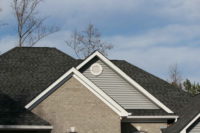Economic Reports
ARMA Q2 2024 Report Shows Gains in All Product Shipments
Mod bit sees largest shipment in report's history, though year-to-year comparisons are mixed

A highly-reflective roof system on the Campbell House HOA building in Glendale, Calif., installed by ADCO Roofing and Waterproofing that included modified bitumen. Photo courtesy of ADCO Roofing and Waterproofing.
Nearly every product tracked by the Asphalt Roofing Manufacturers Association saw major increases in shipments in Q2 2024, including record highs for some product types.
The latest Quarterly Product Shipment Report from ARMA details the shipments of U.S. and Canadian shingles, BUR, and modified bitumen products in the second quarter of 2024. When compared to shipment numbers in Q1, every product experienced a bump.
Shipments of domestic shingles were reported at 46.7 million squares, an 8.7% increase from the previous quarter. By far not the largest increase in the same time period (seen in 2023 at 52.9%), but also not the lowest recorded.
Built-up roofing (BUR) product shipments came in at 1.4 million squares from the first to second quarter, the lowest Q2 BUR shipment in the report’s history. Despite this, it is an increase of 22.6% from the previous quarter, which only saw 1.1 million squares shipped. Like Q2, this was the lowest Q1 shipment since ARMA's first reports in 2017.
Modified bitumen experienced its best Q2 in the report’s history, shipping 12.8 million squares. This was a 19.3% increase from last quarter’s shipments of 10.7 million, which was the best Q1 the product category has had. In fact, Q2's shipment amount is the highest on record for any quarter dating back to 2017 for mod bit.
The report shows Canadian shingles had a better quarter as well, shipping 3 million squares. This resulted in a 24.1% growth from last quarter’s 2.5 million, which was the lowest Q1 shipment on record for Canadian shingles.
The numbers bode well for the asphalt roofing product industry. This is the second time each product type saw an increase in shipments from Q1 to Q2 in the report's history. The other occurrence took place in the second quarter of 2022, which showed signs of the world stabilizing after the pandemic despite supply shortages and inflation.
Q2 2024: Year-to-Year Comparisons
Comparing Q2 2024 to the same time period last year reveals mixed news. U.S. shingle shipments are 9.6% lower than Q2 2023, while Canadian shingle shipments are up 27.3%.
Unsurprisingly, with the lowest Q2 amount in the report’s history, BUR is down from Q2 2023 by 21.7%. Modified bitumen shipments enjoyed a modest 5.9% increase from last year’s numbers.
Year-to-date amounts bear out similar results. To date, a total of 89.8 million squares of U.S. shingles have shipped in 2024, which is 5% more than this time last year.
BUR shipments clocked in at 2.6 million at the end of Q2, a 19.4% decrease from 2023 and the lowest year-to-date total, according to ARMA’s report.
Given that mod bit had its best quarter on record, it also saw its highest year-to-date Q2 shipments at 23.5 million, up by 8.3% compared to last year.
Unlike U.S. shingles, their Canadian counterparts dropped by 1.9% to 5.6 million for 2024, which is the lowest year-to-date Q2 total on record.
Roofing product shipment data is collected from participating manufacturers by an independent third party, Association Research Inc., and aggregated to create ARMA’s reports.

Economic Factors
A number of factors are contributing to the relatively positive news of the report, among them being that construction input prices fell 0.3% in June compared to the previous month, while nonresidential construction input prices declined 0.4%.
Even with these drops, input prices are 1.1% higher than a year ago, according to the Associated Builders and Contractors' analysis of U.S. Bureau of Labor Statistics data.
“Construction materials prices dipped in June, perhaps a reflection of declining project starts in a number of construction segments and an associated dip in demand,” said ABC Chief Economist Anirban Basu in a written statement. “For instance, input prices fell in the multifamily segment, where many contractors indicate substantial softening of demand for their services. The same was true of input prices in commercial construction segments.”
The industry isn’t out of the woods yet with inflation. According to Basu, the Federal Reserve is still looking for data indicating that 2% inflation will soon be reestablished, which could stall much-desired interest rate cuts.
“That translates into higher interest rates for longer, which would be damaging to construction industry prospects,” he said.
Contractors remain confident despite these hindrances thanks in part to robust backlogs. Associated Builders and Contractors says its Construction Backlog Indicator increased to 8.4 months in June, down 0.5 months from June 2023. Meanwhile, the association's Construction Confidence Index readings for sales and staffing levels fell slightly in June, while the reading for profit margins improved. The readings remain above the threshold of 50, indicating expectations for growth over the next six months.
“The combination of slowing inflation and softening growth suggests that the Federal Reserve may begin to lower interest rates as soon as September,” said Basu. “That will buoy backlog as some of the softer construction segments, like office and commercial, benefit from lower borrowing costs and looser lending standards.”
Looking for a reprint of this article?
From high-res PDFs to custom plaques, order your copy today!







